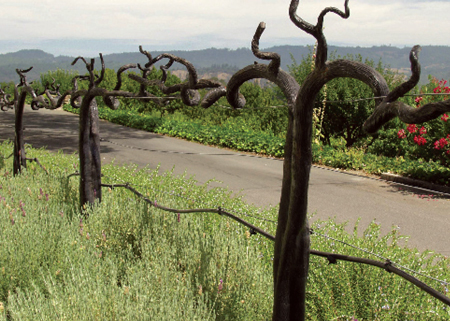A Napa Valley History Tour
Ghost Wineries
With October upon us, it’s only fitting to remember the “ghost wineries” from Napa Valley’s past. Ghost wineries are those 700-or-so estates that were built (and mostly abandoned) in the Napa Valley before Prohibition and the phylloxera epidemic of the early 1900s. Unfortunately, the Napa Valley Land Trust is no longer offering its annual ghost winery tour, but many of the wineries themselves are still there to explore.
One example is Ladera Vineyards, owned and operated by Pat Stotesbery, a longtime board member of the Wine Institute, founder and former president of the Howell Mountain Vintners and Growers Association, and current president of the Napa Valley Vintners Association. During the remodeling of Ladera, which he purchased as Chateau Woltner in 2000, Stotesbery made sure to preserve as much as possible from the original winery, Nouveau Medoc, built in 1886 by French partners Jean Brun and W. J. Chaix. “Essentially everything you see at Ladera that’s made out of wood is recycled from the original building,” he points out. “When people (today) go on a tour I think they are pretty impressed with the forethought of construction methodologies used in a time without electricity.” That includes walls that are 30 inches thick and still up to county code, despite having been built 125 years ago; a structure built into a hillside so that three floors were all accessible by auto or wagon; and use of gravity (liquid flows from third floor to first) in lieu of pumps.
Here’s a chronological look at some other erstwhile wineries and their current incarnations. All are open to the public, though some require that you call ahead if you want to visit the property via a private tasting.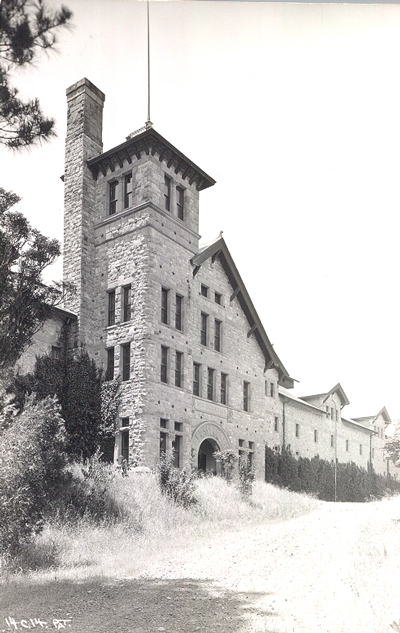
1840: Russian fur trader Gustave Niebaum founded Inglenook winery, which earned international accolades within 10 years. Today the property is home to Rubicon Estate.
1861: While Charles Krug built his namesake winery, the Mondavi family put it on the map. In 1965 Robert Mondavi broke away from the family business to start the first new large-scale winery to be established in the valley since before Prohibition.
1862: Jacob Schram, fresh from Germany, founded Schramsberg. The property is still run under the family name and still making sparkling wine.
1870: Villa Miravalle, built by Tiburcio Parrott, is now Spring Mountain Vineyard, which has been making wines under the SMV label since 1968.
1880: Swiss wine merchant Frank Sciaroni set up his sherry distiller in the same brick building on the northeast corner of Main Street and Charter Oak Avenue that now houses one of the region’s best-known restaurants, Tra Vigne.
1882: It is said to have cost Bordeaux’s Michel Reybier of Château Cos-d’Estournel up to $150 million to purchase the historic Chateau Montelena winery this summer. Funny, given that at the famed Judgment of Paris competition, a 1973 chardonnay from this very vineyard beat out French bottlings in a 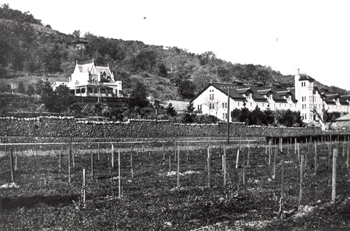 blind taste test.
blind taste test.
1883: Brothers Adam and Jacob Grimm founded Grimms Vineyards and WineVault, which included caves built into the mountains above Calistoga. Today you can tour these same caves at Storybook Mountain Vineyards.
1884: The red barn used by the historic Adamson Winery is home to Frog’s Leap, established in 1994 and famous for its organically grown wine.
1885: Entrepreneur John Benson built his dream winery on the same spot where Far Niente has stood since 1979.
1885: What was originally Bergfeld winery, built by a New England ship captain, is now home to Hall Winery. The tour here includes a visit to the original tasting room.
1886: Brun and Chiax built Nouveau Medoc, which became Ladera Vineyards.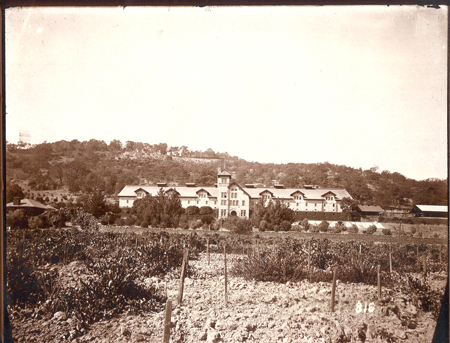
1889: Christian Brothers winery—later Greystone Cellars—was built; in 1991 this site became the West Coast campus for the Culinary Institute of America.
1890: What was originally Summit Vineyards is now home to Pride Mountain Vineyards. Its cabernet sauvignon reserve ’96 was selected as a “top five” by Robert Parker in a recent newsletter.
1906: Pagani Brothers Winery is now home to Kenwood Vineyards.
Read more about it: Other details about these historically significant properties are revealed in Ghost Wineries of Napa Valley by Irene W. Haynes, published by theWine Appreciation Guild (San Francisco, 1995).
CAPTION: (Three historical images above) Historical images of The Culinary Institute of America at Greystone.
Premium Hikes
Burn those wine country calories on these top-rated trails
Weekends in wine country are usually all about eating and drinking. For those who need some activity to balance the indulgence, here are some top-flight hikes suggested by Tiffany MacNeil, activities manager at Calistoga Ranch. MacNeil has lived in the wine country for over 10 years and been professionally leading hikes for seven, so she’s got the 411 on area treks.
All day (10 miles or more). Two options in Robert Louis Stevenson State Park, located on Highway 29 about eight miles out of Calistoga: Palisades Trail, or a hike to the top of Mount St. Helena. Both are accessible from the entrance to the park; the trailheads are across the road from each other at the same location.
Palisades Trail Starting as the Table Rock Trail, this trail follows a rugged volcanic wall that rises from the valley floor above the town of Calistoga. Rated one of the best hikes in Napa by the New York Times, it’s one of MacNeil’s favorites too. Start in early morning or late afternoon (for the shorter turnaround hike to Table Rock) to see the ultimate light show on the ancient band of igneous rocks. Best as a one-way hike, which requires a car at each end, but if you turn around at Table Rock it’s 4.4 miles round trip; or turn back at Holm’s Place, an old homestead, and it’s 12.2 miles. (Calistoga) 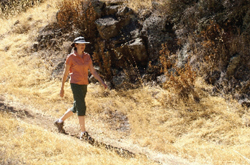
Mount St. Helena Earn (or burn) that five-course dinner by climbing the tallest peak (4,343 feet) in the Bay Area. It’s a 10-mile round trip and a 2,000-foot-climb to the top. From the Robert Louis Stevenson sign, turn left and follow the path to the top. The first mile is in the woods and shaded; the rest is exposed—so bring sunscreen. The trail winds up the mountain, with great views all the way. Take a snack or picnic for the top and enjoy the 360-degree views before heading down. (Calistoga)
Shady Hikes
Redwood Trail at Bothe State Park Entrance on Highway 29, a few miles north of St. Helena’s Main Street. Drive or bike into the park, past the history museum, and start on the trail at the signage on the right. Walk under redwoods and past ferns along Ritchey Creek, which runs all year long. The first loop extends two miles, while other well-marked trails can be accessed for longer hikes, with a trail past the summer home of the Hitchcock family, who came up from San Francisco in the 1870s for fresh air and to host lively social gatherings for the city’s moneyed crowd. Another option is the History Trail (different trailhead, same park), which takes you to historic Bale Grist Mill, a running 36-foot waterwheel mill from 1846 that still grinds flour. (Calistoga)
Jack London State Park From the upper parking lot, a 1.5-mile round-trip hike goes past farm buildings up to the lake where London spent his summers with famous literary friends, then returns to visit his home, now a museum. A short trail from the lower parking lot leads to London’s grave and to the spectacular ruins of Wolf House. (Glen Ellen, in Sonoma)
Lawndale Trail at Annadel State Park Find this 5,000-acre park along Highway 12 at the northern end of Sonoma Valley. There are many bike, horse and hiking trails; MacNeil’s favorite is the Lawndale Trail, a steady but manageable uphill walk with lots of newts and seasonal creeks in the rainy season. And it’s one of the few places to hike above the fog layer in winter, when bright sunshine is a welcome sight. (Kenwood, in Sonoma Valley)
Hike with a View
Gunsight Rock at Sugarloaf State Park Get to the top of this seven-mile grueling uphill climb for 360-degree views of the Bay Area to the Sierras. The hike starts somewhat slow through a grassy meadow, then quickly gets into the burning switchbacks. Bring your hiking poles if you have them. The trailhead is well signed, on the north end of the parking lot. Take a lunch to savor along with the views at the top, where you can sit on the edge of a rock outcropping and dangle your feet over the valley below. (Kenwood, Sonoma Valley)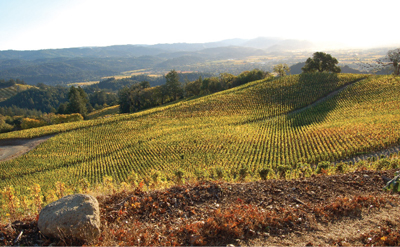
Oat Hill Mine Trail The Chronicle’s Tom Stienstra calls it a “thigh-burning, knee-wrenching, toe-jamming experience, only for the deranged.” MacNeil agrees, but enjoys bringing seasoned hikers on this steady climb that yields views of Napa Valley almost right away. One-way it’s 4.5 miles to Holm’s Place, a good spot to turn around, but many turn back after getting to the shady rock vista point, two miles up. (Calistoga)
Batholomew Park Winery A rolling two-mile loop, crossing rambling creeks through hills deep in the woods, with a lot of wooden steps. Expansive views of Sonoma and the Golden Gate Bridge on a clear day await at the top; wine tasting and a choice of many picnic areas beckon below. (Sonoma)
Flat Hikes
Overlook Trail Easily accessible from downtown Sonoma to walkers of all abilities, this is a great stroll offering expansive views for not much effort. The trailhead is marked by a sign in a small parking lot (across from the cemetery) just past the Veterans Memorial Building on First Street. Besides views of the wine country, expect to see a beautiful variety of oaks and grass woodlands, pristinely preserved. (Sonoma)
Sonoma Valley Regional Park Choose the paved level trail rambling through oaks that are the homes of many acorn woodpeckers. Very (leashed) dog-friendly on trail; for unleashed fun, opt for the on-site large dog park. (Glen Ellen)
Riverfront Regional Park Among the vines off Eastside Road, enjoy this totally flat, wide two-mile loop path around a large reservoir. You’ll also find great picnic tables under huge redwoods, where it is cool even on the hottest summer day. (Healdsburg)
Four New Hot Spots
After exploring local hikes, experience the flavors from new culinary treasures of the region.
25º Brix Restaurant The recently unveiled restaurant has a farm-to-table focus, with new gardens and orchards planted on site to provide seasonal fruits, vegetables and wine for the restaurant’s daily-changing menu. Executive chef Carlos Cañada and executive pastry chef Andrea Mautner have created a menu inspired by the culinary traditions of the wine-growing regions in southern France and northern Italy. The name reflects the sugar level at which the grapes for Kelleher Family Vineyard’s Cabernet Sauvignon are harvested. The modern, urban farmhouse decor includes a 70-seat dining room, three private dining rooms and an outdoor patio. 7377 St. Helena Hwy, Napa, 707.944.2749, 25degreesbrix.com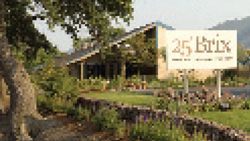
Diavola Executive chef Dino Bugica and owner Doug Swett recently unveiled Diavola, sister restaurant to Geyserville’s Santi. The casual, family-style pizzeria and salumeria highlights local produce and small-production Italian wines. The 1,200-square-foot restaurant includes an Italian wood-burning oven, a small altar to San Lorenzo, the patron saint of cooks, and a rotating collection of artwork. A seasonal menu features items like octopus with celery hearts, pickled zucchini with mint from the cold deli, and whipped Bellwether Farms ricotta and thyme as a cheese selection as well as specialty pizzas. 21021 Geyserville Ave, Geyserville, 707.814.0111, diavolapizzeria.com
Ubuntu Newly opened Ubuntu features daily harvested food with a focus on produce from its own biodynamic gardens. The majority of the menu’s 200 wines come from sustainably farmed grapes, and the restaurant’s interior reflects a sustainable touch, with reclaimed wood flooring and furnishings and recycled patio furniture from the ’40s. An upstairs yoga studio offers 53 different classes per week. 1140 Main St, Napa, 707.251.5656, ubuntunapa.com
La Toque at the Westin Verasa Chef Ken Frank has moved his award-winning restaurant La Toque from its Rutherford location to the newly opened Westin Verasa. Named one of the “Best Restaurants in America” by Wine Spectator magazine, La Toque has a seasonal menu and a patio for savoring Napa’s warm weather. 1314 McKinstry St, Napa, 707.257.1800,
starwoodhotels.com

Mimi Towle has been the editor of Marin Magazine for over a decade. She lived with her family in Sycamore Park and Strawberry and thoroughly enjoyed raising two daughters in the mayhem of Marin’s youth sports; soccer, swim, volleyball, ballet, hip hop, gymnastics and many many hours spent at Miwok Stables. Her community involvements include volunteering at her daughter’s schools, coaching soccer and volleyball (glorified snack mom), being on the board of both Richardson Bay Audubon Center. Currently residing on a floating home in Sausalito, she enjoys all water activity, including learning how to steer a 6-person canoe for the Tamalpais Outrigger Canoe Club. Born and raised in Hawaii, her fondness for the islands has on occasion made its way into the pages of the magazine.

